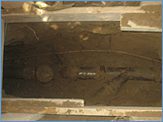Using Hydraulic Cement to Fix a Leaky Basement
New Canadian Drain & Plumbing uses innovative solutions for fixing leaky basements in Toronto
 Over the years, we have been amazed by how ingenious — but ultimately unsuccessful — homeowners have been when trying to fix a leaky basement on their own, rather than by calling a professional for help. We have seen homeowners attempt a wide range of “solutions” to stop their basement from leaking, such as the use of chewing gum or plumbers putty stuck in cracks in walls and floors, duck tape wrapped around pipes, or even wet-dry shop vacuums used in place of a dedicated sump pump.
Over the years, we have been amazed by how ingenious — but ultimately unsuccessful — homeowners have been when trying to fix a leaky basement on their own, rather than by calling a professional for help. We have seen homeowners attempt a wide range of “solutions” to stop their basement from leaking, such as the use of chewing gum or plumbers putty stuck in cracks in walls and floors, duck tape wrapped around pipes, or even wet-dry shop vacuums used in place of a dedicated sump pump.
These are all “Band-Aid” solutions at best and good for a few laughs, but the professionals at New Canadian Drain & Plumbing have been called upon for leaky basement repairs year after year and know what it takes to make these problems disappear. One classic solution that does not get the love it deserves is hydraulic cement.
Fixing a Leaky Basement with Hydraulic Cement
Unlike Portland Cement, the most common type of cement used worldwide for general construction, hydraulic cement does not shrink as it dries. When mixed with water, Portland Cement contracts as it dries. Not only that, but it is not a good solution to leaky basement repairs because it cannot be used in a situation where it is applied on top of standing water or leaks from a crack.
The beauty of hydraulic cement as an option for wet basement repair is two-fold. First of all, it can be applied in a wet environment with leaking or standing water. Secondly, it expands as it dries, filling the insides of cracks or holes and effectively stopping the spread of water to other areas.
What is Hydraulic Cement Made From?
Because it sets when exposed to water, hydraulic cement is an ideal solution to stop a leaky basement. Its usefulness is based on its chemical composition, or the ingredients that are used to make it. Hydraulic cement is made from the following:
- Tricalcium silicate, which gives hydraulic cement its strength.
- Dicalcium silicate, which supplements Tricalcium silicate by furthering hardening the hydraulic cement up to one week after the initial application.
- Tricalcium aluminate is a component that helps manage heat distribution as hydraulic cement hardens.
- Tetracalcium aluminoferrite helps hydraulic cement harden, even in cooler temperatures that may be typical of a leaky basement or crawl space area.
In order to apply hydraulic cement, the cracked area needs to be cleaned out. For cracks in walls or floors, it is advisable to remove loose debris using a wire brush, and dispose of the rest before starting repairs. When filling cracks or holes, make sure the cement mixture gets as far into the opening as possible.
Standard Disclaimers
There are many other options to consider if you have a wet basement, but if you decide to use hydraulic cement, a few words to the wise: It should not be applied when the temperature is below 40 degrees Fahrenheit or expected to fall below 40 degrees; make sure you wear protective clothing when applying it to cracks or holes. Visit us on Google+


